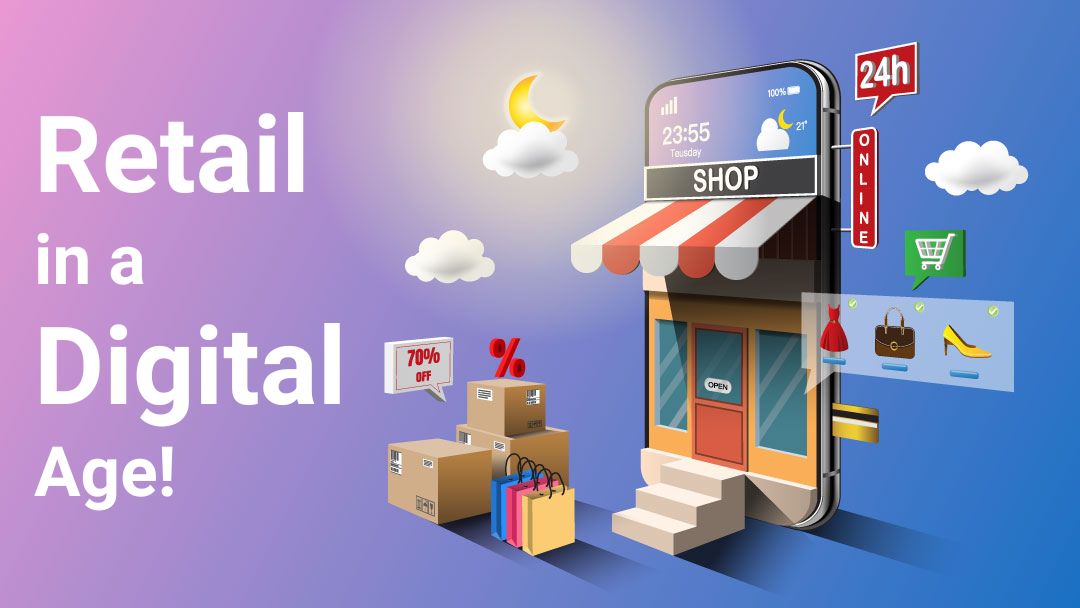Retail in a digital age refers to the way traditional brick-and-mortar stores are adapting to the rise of e-commerce and online shopping. With the advancements in technology and the increasing use of the internet and mobile devices, retailers need to incorporate digital strategies to stay competitive and meet the changing needs of consumers. Some key aspects of retail in a digital age include:
1) E-Commerce: Retailers are setting up online stores or partnering with e-commerce platforms to reach a wider audience and cater to the growing number of online shoppers.
2) Omni-Channel Retailing: Retailers are adopting an omni-channel approach, which integrates their physical stores with online channels. This means providing customers with a seamless experience across different channels, such as in-store, online, mobile apps, and social media.
3) Personalization: Digital technologies enable retailers to gather data on customers’ preferences and shopping behaviours. This data can be used to personalise the shopping experience by offering tailored recommendations, discounts, and promotions.
4) Mobile Commerce: With the increasing use of smartphones, retailers are focusing on developing mobile apps and optimising their websites for mobile devices. This allows customers to conveniently shop on their mobile devices and receive notifications about sales, discounts, and new products.
5) Data Analytics: Retailers are leveraging data analytics to gain insights into customer behaviour, market trends, and inventory management. This helps them make informed decisions and improve their marketing strategies.
6) Augmented Reality (AR) and Virtual Reality (VR): Retailers are exploring the use of AR and VR technologies to enhance the shopping experience. Customers can virtually try on clothes, visualise furniture in their homes, and experience retail environments in a digital space.
7) Social Media Marketing: Retailers are using social media platforms to connect with customers, promote their products, and receive feedback. Social media platforms also provide opportunities for direct sales through “buy” buttons and ad targeting based on user preferences.
8) Supply chain optimization: Retailers are leveraging technology to improve supply chain management. This includes inventory management systems, automated warehousing, and real-time tracking for efficient order fulfilment and delivery.
Overall, retail in a digital age requires a shift in strategies and embracing technology to meet the demands of modern-day consumers, who increasingly rely on digital channels for their shopping needs.
Retail challenges in the digital age
Some of the challenges faced by the retail industry are:
1) Online Competition: With the rise of e-commerce giants like Amazon, traditional brick-and-mortar retailers face stiff competition in the digital space. Online retailers often offer lower prices, faster delivery, and a wider selection of products, making it challenging for brick-and-mortar stores to stay competitive.
2) Showrooming: Showrooming occurs when shoppers visit physical stores to see and try out products before making a purchase online, often at a lower price. Retailers struggle to convert these showrooming experiences into sales within their own stores, resulting in lost revenue.
3) Changing Consumer Behaviour: The digital age has transformed the way consumers shop. Online shopping provides convenience, personalization, and the ability to compare prices and products easily. Retailers must adapt to changing consumer preferences by offering omnichannel experiences that seamlessly blend online and offline shopping.
4) Data Security and Privacy: Retailers collect vast amounts of customer data to personalise the shopping experience and target marketing campaigns. However, this also puts them at risk of cyberattacks and data breaches. Ensuring data security and protecting customer privacy is a major challenge in the digital age.
5) Adapting to New Technologies: Advancements in technology, such as AI, automation, and virtual reality, have the potential to revolutionise the retail industry. However, implementing and integrating these technologies into existing retail operations can be costly and complex, posing challenges for many retailers.
6) Rising Customer Expectations: The digital age has raised customer expectations for personalised experiences, fast delivery, easy returns, and seamless online/offline interactions. Meeting these expectations requires retailers to invest in technology, logistics, and customer service, which can be difficult for smaller retailers with limited resources.
7) Supply Chain Management: Online shopping has increased the complexity of supply chain management for retailers. They must ensure smooth inventory management, efficient order fulfilment, and timely delivery to meet customer expectations. This requires integration with technology and logistics providers to optimise operations.
8) Building Brand Loyalty: With countless online retailers competing for consumer attention, building and maintaining brand loyalty is a challenge. Retailers must create unique value propositions, engage customers through personalised experiences, and cultivate strong customer relationships to differentiate themselves in the digital age.
Retail opportunities in the digital age
There are several opportunities for retail in the digital age. Some of these include:
1) E-Commerce: The rise of online shopping has provided retailers with the opportunity to reach a global audience and expand their customer base. By setting up an online store, retailers can increase sales and cater to the growing number of consumers who prefer shopping online.
2) Mobile Commerce: With the proliferation of smartphones, retailers can take advantage of mobile commerce to engage with their customers wherever they are. Mobile apps and optimised websites allow retailers to provide personalised offers, promotions, and a seamless shopping experience.
3) Omni-Channel Retailing: Customers today expect a seamless experience across multiple channels, including physical stores, online platforms, and mobile devices. By adopting an omnichannel approach, retailers can provide a consistent shopping experience and meet the customer’s needs and preferences.
4) Data Analytics: The digital age has provided retailers with a wealth of data that can be leveraged to gain insights into customer behaviour, preferences, and purchasing patterns. By utilising data analytics tools, retailers can improve their product offerings, marketing strategies, and customer targeting.
5) Personalization: Digital technologies enable retailers to offer personalised experiences to their customers. By tracking customer preferences and purchase history, retailers can provide customised recommendations, promotions, and offers, enhancing customer satisfaction and loyalty.
6) Social Media Marketing: Social media platforms offer retailers the opportunity to connect with their target audience, build brand awareness, and engage with customers in real time. Through social media marketing, retailers can create compelling content, run targeted ads, and leverage customer reviews to drive sales.
7) Augmented Reality and Virtual Reality: Retailers can use augmented reality and virtual reality technologies to enhance the shopping experience. Customers can virtually try on clothes, visualise products in their homes, or explore virtual stores, providing a more immersive and interactive experience.
8) Supply Chain Optimization: Digital technologies can help retailers optimise their supply chain processes, leading to reduced costs, improved inventory management, and faster delivery times. By leveraging technologies such as RFID tracking, AI-powered forecasting, and automation, retailers can streamline their operations and meet customer demands more efficiently.
Overall, the digital age presents numerous opportunities for retail, allowing them to adapt, innovate, and create more engaging and personalised experiences for their customers.
Impact of digitalization on the retail industry
Digitalization has had a profound impact on the retail industry, transforming how consumers shop and how retailers operate. Some key impacts of digitalization on the retail industry include:
1) Changing Consumer Behaviour: Digitalization has given rise to an omnichannel shopping experience, where consumers can seamlessly switch between online and offline channels. This has led to changing consumer expectations, with a growing demand for convenience, personalization, and a seamless shopping experience across different platforms.
2) E-Commerce Growth: The rise of e-commerce platforms has allowed retailers to reach a wider customer base and expand their geographical reach. Online shopping has grown in popularity as it offers convenience, access to a wide range of products, and often lower prices compared to physical stores.
3) Mobile Shopping: The proliferation of smartphones has made it easier for consumers to shop anytime, anywhere. Mobile shopping has become increasingly popular, with consumers using their smartphones to research products, compare prices, and make purchases. Retailers have had to adapt by optimising their websites and creating mobile apps to enhance the mobile shopping experience.
4) Personalization and Data-Driven Marketing: Digitalization has enabled retailers to collect vast amounts of customer data, allowing for personalised marketing and targeted advertisements. Retailers can analyse buying patterns, preferences, and behaviour to offer personalised recommendations and tailored promotions, enhancing the overall shopping experience for customers.
5) Supply Chain Optimization: Digitalization has enabled retailers to optimise supply chains, improving inventory management, and streamlining logistics. With the use of data analytics and automation, retailers can better forecast demand, reduce stockouts, and streamline the fulfilment process, ultimately leading to cost savings and improved customer satisfaction.
6) Technological Advancements: Digitalization has brought about various technological advancements that have revolutionised the retail industry. These include the use of artificial intelligence (AI), augmented reality (AR), virtual reality (VR), and chatbots. AI-powered chatbots assist customers with inquiries, AR allows customers to virtually try on products, while VR enhances the in-store experience.
Overall, digitalization has disrupted the traditional retail industry, forcing retailers to adapt to changing consumer demands and embrace digital technologies to stay competitive. Those who have successfully integrated digital strategies and embraced digital transformation have reaped numerous benefits, while those who have resisted or lagged behind have faced challenges in remaining relevant in an increasingly digitised marketplace.
SUMMING UP
The retail industry has undergone significant changes with the advent of technology and the digital age. The shift towards online shopping has disrupted traditional brick-and-mortar stores, leading to the closure of many retail outlets. Retailers have had to adapt their strategies to meet the demands of tech-savvy consumers who prefer the convenience and ease of shopping online.
E-commerce platforms have emerged as a dominant force in the retail landscape, with giants like Amazon leading the way. This has forced retailers to invest in their own online presence and create user-friendly websites and mobile apps to compete in the digital market. Hence, the ability to provide a seamless shopping experience across various digital platforms has become crucial for retailers.

